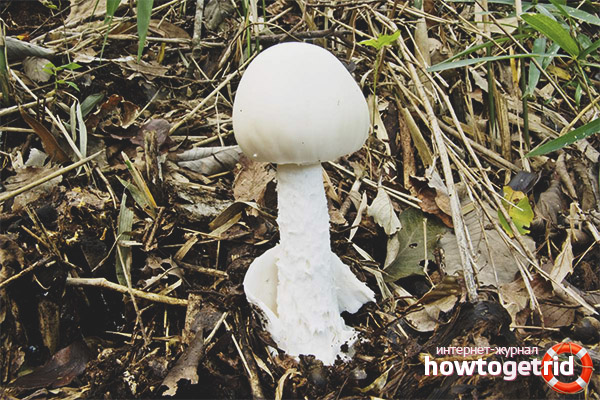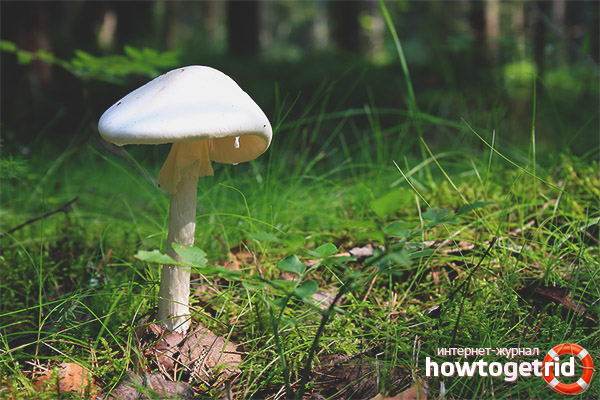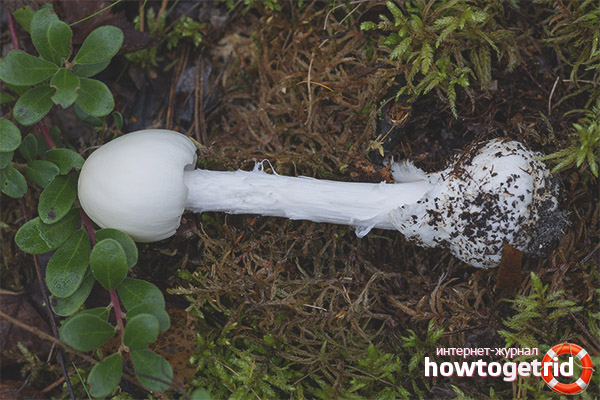The content of the article
Every fan of the “quiet” hunt knows that mushrooms have a great taste, and also contain a large amount of nutrients. To search for them is a pleasure, and to feast on them is, perhaps, an even greater pleasure. Indeed, if this were not so, then why would they be collected at all?
However, mushroom pickers know firsthand the insidiousness of the mushroom kingdom, when instead of a tasty dish on the table, you can get a hospital bed or, even worse, a small wooden box with a lid. Danger can wait under every bush and in any clearing. Many mushrooms, bearing a striking resemblance to the edible representatives of their kingdom, mistakenly fall into the basket of mushroom pickers, which leads to grave consequences. One of such mushrooms can be considered a fly agaric smelly.
Appearance and characteristic
This mushroom is a representative of the Agarikomycetous family, the Mukhomorov family. The genus Mukhomorov, which also includes the smelly fly agaric, is quite significant and has several dozen species. Almost all of them are inedible or poisonous, white grebe is no exception. It belongs to one of the most deadly poisonous mushrooms. In its configuration and chemical composition, the snow-white grebe resembles a pale grebe very much.
Amanita smelly got its official name for the unbearable stench emanating from it. The second, common name - a white (snow-white) grebe - appeared for the presence of a boletus-white hat in a fly agaric.
Indeed, the smelly fly agaric has a bright white, less often grayish or yellowish hue of the fruiting body.
The plates, often located on the back of the cap, are thin and dense. Between the plates there is a spore powder, upon inhalation of which temporary asphyxiation may occur.
The pulp is white, dense, when broken does not change color. It has a sickening smell that grows with age, and a disgusting taste.
The leg is located in the center, has a cylindrical shape, expands to the bottom. Its thickness is 1-2 cm, its length is from 7 to 15 cm. The leg has a rough-scaly surface, a dense fibrous ring is observed near the cap, which disappears over time. At the end of the leg, underground is a cup-shaped Volvo with free edges.
Distribution area

White grebe grows everywhere, but prefers marshy and damp places. Most often, the mushroom chooses mixed and deciduous forests, somewhat less coniferous. Amanita smelly forms mycorrhiza, being in close symbiosis with a tree. The growth season lasts from the end of July - to October, almost until the frost. It grows in small groups or individually.
Amanita smelly is very common in northern temperate latitudes.
Similar views and how to distinguish
Despite the repulsive smell, a white grebe is still occasionally caught in mushroom baskets. There is a simple explanation for this: the mushroom is very similar in appearance to some types of edible mushrooms. These include:
- Champignon coppice. At first glance it is difficult to distinguish from a white grebe, but there are still differences.Champignon has an egg-shaped form of a hat, under which reddish-brown plates and a yellowish ring are hidden. There is no Volvo at the end of the leg. Upon breaking, the mushroom flesh darkens.
- The volvariella is beautiful. This fungus has no ring, and the plates are pink.
- The float is white. The float is white more elegant and fragile with respect to the smelly fly agaric. The leg inside is hollow, has no ring. The edge of the hat is streaked with small stripes.
The most important distinguishing feature of all similar edible mushrooms from smelly fly agaric is the absence of a sharp unpleasant odor.
Poisonous Amanita smelly
Due to the presence of a fetid amber in a white toadstool, poisoning with it occurs much less often than with other types of poisonous mushrooms. Basically, this happens with novice mushroom pickers, for experienced snouts the stinky smell of the mushroom will surely push away.
Amanita is smelly - a very toxic and deadly mushroom. It consists of a destructive for a person virosine, in large quantities contains amatoxins and phallotoxins. The toxicity of the fungus is so great that it is not even recommended to collect edible species of mushrooms that grow near it. Disputes carried by the wind are also extremely toxic and can get into useful specimens.
Note! It is strictly forbidden to take the mushroom with bare hands and it is absolutely forbidden to eat. In order for death to occur, it is enough to eat 1/3 of the cap.
Symptoms of poisoning and first aid
Amanita smelly - a very insidious mushroom. Signs of poisoning do not manifest themselves immediately, but after a few hours or even 1.5 days. At this time, the body of an unsuspecting person is already undergoing irreversible destructive processes. The time for therapy has already been lost, the treatment is untimely and, at times, completely meaningless.
Manifestation of poisoning:
- Initially, poisoning affects the liver. This happens against the background of the general well-being of the poisoned, while the toxins only penetrate the body.
- The first visible signs are nausea, excessive salivation, chills, and thirst.
- Then there is repeated vomiting and pain in the abdomen. Cramps occur in the arms and legs.
- Tachycardia and diarrhea develop. In liquid stool, blood impurities are observed. Dehydration causes great damage to the kidneys.
- A period of improvement begins on 2-3 days, but this condition is deceptive. Real recovery does not occur, toxins methodically kill all living things in the body.
- During this period, it is extremely important to provide first aid to the victim and call an ambulance, otherwise, after 10-12 days, a fatal outcome is possible.
Necessary actions for intoxication:
- Call an emergency team of doctors.
- Rinse the stomach.
- Take sorbents and laxatives.
About 50% of the poisoned die, most often they are children. In some especially difficult cases, a liver transplant is done to save the patient - this is the only chance to stay alive.
Video: Amanita smelly (Amanita virosa)











Submit